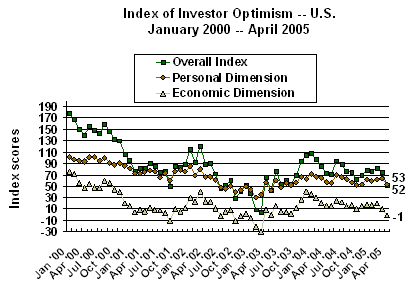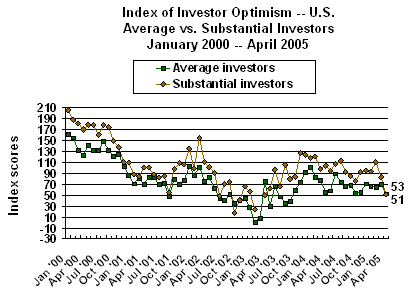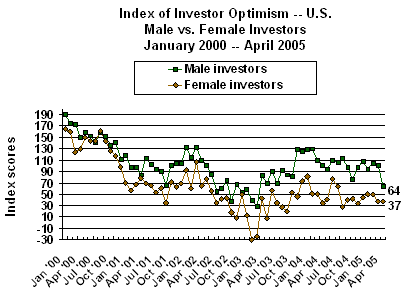GALLUP NEWS SERVICE
PRINCETON, NJ -- Last week, Federal Reserve Board Chairman Alan Greenspan noted while testifying before the Senate Banking Committee that, "The U.S. economy delivered a solid performance in 2004, and thus far this year, activity appears to be expanding at a reasonably good pace." He went on to express his concerns about the nation's growing budget deficit and its potential to create economic stagnation in the longer term.
While the Fed Chairman put the potential for economic stagnation in a future context, the "stagflation" -- increasing prices with little or no economic growth -- bandwagon seems to be gaining new adherents, according to the April UBS/Gallup Index of Investor Optimism Poll. Overall investor optimism is now at its lowest level since May 2003 -- shortly after the beginning of hostilities with Iraq. More importantly, optimism among substantial investors -- those having $100,000 or more of investable assets -- fell sharply in April. Econometric analysis suggests that the trend in substantial-investor optimism is an even better predictor of future economic trends than is the overall Index of Investor Optimism.
As far as the future is concerned, it looks like Greenspan and President George W. Bush have a long way to go to get investors focused on the longer term. For example, even with all the talk about the longer-term problems facing the Social Security system, investors remain about where they were in January on the issue -- evenly split over whether there is even a need for major reform.
Investor Optimism Drops
The Index of Investor Optimism fell 22 points in April on top of its 8-point decline in February, putting the Index at 52, down from 82 in February and 74 in March. The Index is now at its lowest level of the year and its lowest point since May 2003, when it stood at 42. The April decline is due to an 11-point drop in both the Personal and the Economic Dimensions of the Index. Currently at -1, the Economic Dimension is at its lowest level of the year. In April, investors are more pessimistic about economic growth, inflation, and the stock market. At this point, investors as a whole are neutral, if not slightly pessimistic, about the future direction of the U.S. economy.

Substantial-Investor Optimism Takes a Plunge
Substantial-investor optimism plunged 32 points in April on top of its 28-point drop in March, leaving the Index among substantial investors at 51. This is less than half of its February level and its lowest point since April 2003. Substantial-investor optimism is now at the same level as that of average investors (those having at least $10,000 of investable assets but less than $100,000). Average-investor optimism also declined in April, but by far fewer points (16), and now stands at 53, its lowest point since September 2003.

Investor Optimism Among Men Plummets
Optimism among male investors dove 38 points in April, bringing the Index among this group to 64. On the other hand, optimism among female investors remained unchanged in April, at 37. While optimism among male investors fell sharply this month, male investors remain nearly twice as optimistic as their female counterparts.

No Progress on Social Security Reform
Another point that Chairman Greenspan made last week in his testimony to the Senate Budget Committee involved the promises made to older Americans: "I fear that we may have already committed more physical resources to the baby-boom generation in its retirement years than our economy has the capacity to deliver." While Greenspan's comment clearly also includes concerns about Medicare, it could be interpreted as indirectly supporting the Bush effort to reform Social Security.
That effort, however, is not making progress, according to our investor poll. For example, investors remain evenly divided on whether the system needs major changes or a complete overhaul on the one hand (50%), or whether it needs some minor adjustments or is fine the way it is on the other (49%). Similarly, only 47% of investors favor using part of Social Security funds to create personal savings accounts, while 50% favor staying with the current system. These results are essentially the same as those from January. They suggest that the president's efforts to build support for this "private accounts" idea have not succeeded, even with investors -- who would presumably be more likely than other Americans to support the idea.
"Stagflation" Seems Likely
Given these investor poll results, it is not surprising that President Bush gave a major speech last week, asking Congress to pass his long-proposed energy legislation. Clearly, a $50+ per barrel oil price is doing serious damage to both consumer confidence and consumer disposable incomes. In turn, fears about a drop in consumer spending, with concurrent increases in inflation and interest rates, have investor optimism and the equity markets plummeting. An effort to deal with the energy issue would seem to be a way to at least partially address these deteriorating economic trends.
Unfortunately, even if some form of energy legislation is passed this year, it is unlikely to change the near-term course of the U.S. economy. Even in the face of a pullback in consumer spending, the Fed is liable to increase interest rates once more at its May 3 meeting, in order to defend the dollar and price stability in the face of the nation's increasing trade and budget deficits. At the same time, energy/commodity-driven price pressures are likely to continue to increase current inflationary pressures. In sum, it looks like investors have good reason to fear "stagflation" later this year, and so does everyone else.
Survey Methods
Results for the Index of Investor Optimism poll are based on telephone interviews with 802 investors, aged 18 and older, conducted April 1-17, 2005. For results based on the total sample of investors, one can say with 95% confidence that the maximum margin of sampling error is ±4 percentage points. In addition to sampling error, question wording and practical difficulties in conducting surveys can introduce error or bias into the findings of public opinion polls.
